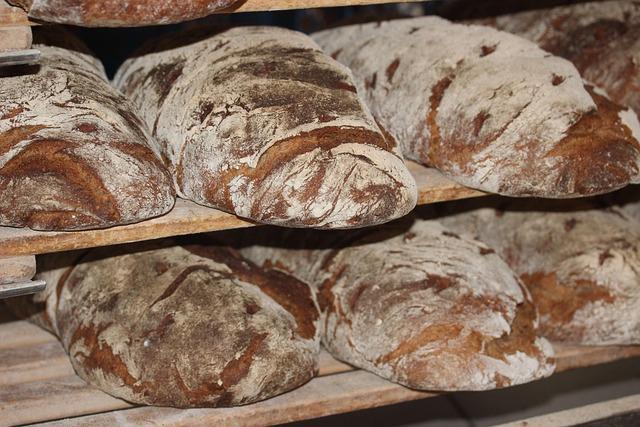Table of Contents
- Understanding the Role of Yeast Blobs in Kombucha Fermentation
- Identifying and Maintaining Healthy Yeast Blobs
- Troubleshooting Common Issues with Kombucha Yeast Blobs
- Enhancing Flavor Profiles through Yeast Blob Management
- Exploring the Health Benefits Associated with Kombucha Yeast Blobs
- Q&A
- Concluding Remarks


Understanding the Role of Yeast Blobs in Kombucha Fermentation
Kombucha fermentation is a fascinating process, primarily influenced by a symbiotic culture of bacteria and yeast, commonly referred to as SCOBY. Among the myriad microorganisms present in this culture, yeast plays a crucial role, producing not only alcohol but also various flavors and carbonation levels. The yeast blobs, often seen floating in the brew, are live yeast colonies that thrive during fermentation, contributing to the overall complexity of the drink. As they consume the sugars present in the tea, they transform these simple carbohydrates into alcohol and carbon dioxide, which not only enhances the beverage’s taste but also creates that characteristic fizzy sensation.
Several species of yeast can be found within the blobs, including Saccharomyces cerevisiae and Brettanomyces. These species work together with bacteria, primarily Acetobacter, to develop the unique profile of each batch of kombucha. The interaction between yeast and bacteria is particularly fascinating; while the yeast ferments sugars to create alcohol, the bacteria further metabolize this alcohol into acetic acid, contributing to kombucha’s tangy flavor. This harmonious dance between yeast and bacteria is essential for producing the desired balance of sweetness and acidity that kombucha enthusiasts crave.
The presence and behavior of yeast blobs during fermentation can vary significantly depending on several factors, including temperature, sugar content, and the specific strains of yeast and bacteria in the SCOBY. To better understand these variables, consider the following table highlighting the different conditions that affect yeast activity:
| Condition | Effect on Yeast Activity |
|---|---|
| Temperature | Higher temperatures (75-85°F) promote rapid fermentation, while colder temperatures slow down yeast metabolism. |
| Sugar Content | More sugar provides a greater food source, potentially increasing carbonation but also acid production. |
| Yeast Strain | Different strains produce varying levels of alcohol and acids, impacting taste and fizziness. |
Identifying and Maintaining Healthy Yeast Blobs
The presence of yeast blobs in your kombucha fermentation is a natural outcome of the brewing process. These little clumps can seem daunting, but they are an essential part of the SCOBY (Symbiotic Culture Of Bacteria and Yeast). To identify healthy yeast blobs, look for characteristics such as color, texture, and size. Healthy yeast blobs typically appear as brownish or cream-colored and are slightly gelatinous. If your blobs are slimy, overly dark, or exhibit any off-putting odors, it could indicate that they are no longer viable.
Maintaining the vitality of these yeast blobs requires regular attention and care. Ensure your brewing environment maintains a consistent temperature, ideally between 75°F and 85°F (24°C to 29°C), as this range promotes healthy yeast activity. Additionally, keep a watchful eye on the pH levels of your kombucha; ideally, it should stay around 2.5 to 3.5. If the pH becomes too high, it may foster unwanted bacteria and mold, negatively impacting the yeast blobs.
Here’s a quick reference table for maintaining healthy yeast blobs:
| Factor | Ideal Range | Signs of Issue |
|---|---|---|
| Temperature | 75°F - 85°F | Below 70°F or above 90°F |
| pH Level | 2.5 – 3.5 | Above 4.0 |
| Yeast Appearance | Brown/cream, gelatinous | Dark, slimy, foul odor |
Regularly tasting your kombucha will also help you catch any issues early. A healthy brew will have a balanced flavor that’s slightly sweet, tangy, and effervescent, signaling that the fermentation is on track. Keeping an eye on these variables will not only support your yeast blobs but will also enhance the overall quality and taste of your kombucha.


Troubleshooting Common Issues with Kombucha Yeast Blobs
When brewing kombucha, encountering yeast blobs can be an unsettling experience. These gelatinous clumps, often mistaken for spoiled SCOBYs, are typically the result of an excess of yeast proliferation. To address this issue, it’s essential to first ensure that the fermentation environment is optimal. Maintaining the right temperature, ideally between 68°F and 85°F, plays a crucial role in regulating yeast activity.
Another factor contributing to yeast blob formation could be the sugar levels in your brew. If your kombucha is too sweet, particularly during the secondary fermentation, yeast can become overactive. To remedy this, consider the following approaches:
- Reduce the amount of sugar in your initial brew.
- Monitor fermentation time closely to prevent excess sweetness.
- Introduce more starter tea to balance the sugar levels.
If blobs persist, they can often be safely removed or broken apart. Use a clean utensil to gently separate these formations from the main SCOBY. For further clarity, here’s a quick reference table outlining potential causes of yeast blobs and suggested solutions:
| Cause | Solution |
|---|---|
| High sugar content | Decrease sugar in the brew |
| Poor temperature control | Maintain consistent fermentation temperatures |
| Excessive fermentation time | Shorten fermentation cycles |


Enhancing Flavor Profiles through Yeast Blob Management
In the world of kombucha brewing, the management of yeast blobs plays a pivotal role in shaping the ultimate flavor profile of the final product. These clusters of yeast, commonly forming during fermentation, are often seen as an inconvenience, but when handled with care, they can enhance both the taste and texture of your brew. Understanding the microbial ecosystem within your kombucha helps in actively selecting and fostering beneficial yeast strains, thereby elevating the overall fermentation process. Proper care of these blobs not only assures a healthier SCOBY but also leads to a more balanced flavor with nuanced complexity.
Yeast health and activity are directly linked to how these blobs interact with the sugary tea environment. Key management techniques include:
- Regular stirring: This helps to disperse yeast evenly throughout the liquid.
- Temperature control: Maintaining an optimal fermentation temperature prevents excessive yeast growth, leading to milder flavors.
- Sampling: Regularly tasting your brew allows you to identify and adjust the balance between sweet and sour, guiding your yeast management decisions.
Using yeast blobs effectively can transform your kombucha. For example, when you have a thick layer of yeast, it may impart more pronounced flavors, while a sparser blob can lead to a milder drink. To visualize the impact of different yeast management approaches on flavor intensity, the table below summarizes the effects of varying yeast blob sizes during fermentation:
| Yeast Blob Size | Flavor Impact | Mouthfeel |
|---|---|---|
| Small | Light, subtle | Smooth |
| Medium | Balanced & complex | Medium body |
| Large | Strong, bold | Full-bodied |
By exploring the relationship between yeast management and flavor output, brewers can refine their techniques to produce a kombucha that truly embodies their taste preferences. Emphasizing the importance of yeast blob care encourages a proactive approach, allowing creators to delve into the depths of flavor and crafting a beverage that is not only healthy but also uniquely enjoyable.


Exploring the Health Benefits Associated with Kombucha Yeast Blobs
Kombucha is a fermented tea known for its unique taste and health-promoting properties, and at the heart of this effervescent drink are the enigmatic yeast blobs, or SCOBYs (Symbiotic Culture of Bacteria and Yeast). These gelatinous masses are not just for show; they play a pivotal role in the fermentation process, which contributes to the numerous health benefits attributed to kombucha. As these organisms interact with tea and sugar, they generate a complex range of bioactive compounds that can positively influence gut health. Consuming kombucha can enhance digestion, promote a healthy microbiome, and reduce symptoms of gastrointestinal discomfort.
Beyond gastrointestinal health, the antioxidants produced during fermentation are particularly noteworthy. Kombucha boasts a rich supply of polyphenols, which are known for their ability to combat oxidative stress in the body. Regular consumption of these compounds may lead to improved immune function and a lower risk of chronic diseases. The potential anti-inflammatory properties of kombucha can also be beneficial for the body, aiding in recovery from illnesses and overall inflammatory responses.
Moreover, the incorporation of kombucha into daily routines may present a natural boost to mental wellness. Some research suggests that the probiotics and organic acids present in kombucha may positively influence mood and cognitive function. This holistic approach emphasizes the interconnectedness of gut health and mental clarity. With its refreshing flavor, kombucha isn’t just a delightful beverage; it emerges as a multifaceted ally in promoting overall health and well-being.
